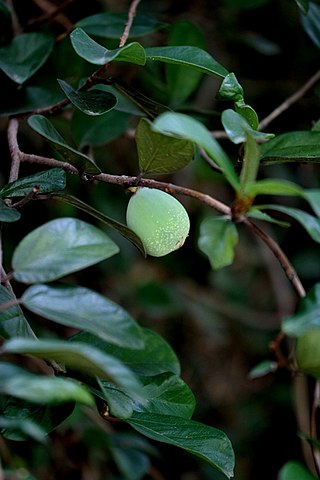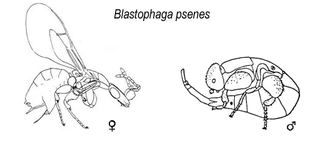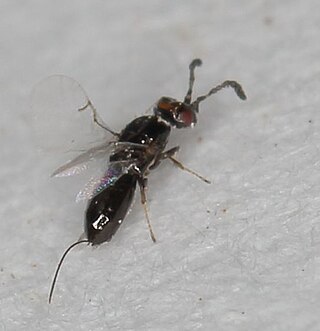
Fig wasps are wasps of the superfamily Chalcidoidea which spend their larval stage inside figs. Some are pollinators but others simply feed off the plant. The non-pollinators belong to several groups within the superfamily Chalcidoidea, while the pollinators are in the family Agaonidae. While pollinating fig wasps are gall-makers, the remaining types either make their own galls or usurp the galls of other fig wasps; reports of their being parasitoids are considered dubious.

Chalcid wasps are insects within the superfamily Chalcidoidea, part of the order Hymenoptera. The superfamily contains some 22,500 known species, and an estimated total diversity of more than 500,000 species, meaning the vast majority have yet to be discovered and described. The name "chalcid" is often confused with the name "chalcidid", though the latter refers strictly to one constituent family, the Chalcididae, rather than the superfamily as a whole; accordingly, most recent publications (e.g.,) use the name "chalcidoid" when referring to members of the superfamily.

Ficus pumila var. awkeotsang, the jelly fig, is a variety of Ficus pumila, and a member of the fig family Moraceae. Awkeotsang is Taiwanese, named after the daughter (Aiyu) of the individual who discovered gel-forming properties in 1921.

Ficus americana, commonly known as the West Indian laurel fig or Jamaican cherry fig, is a tree in the family Moraceae which is native to the Caribbean, Mexico in the north, through Central and South America south to southern Brazil. It is an introduced species in Florida, USA. The species is variable; the five recognised subspecies were previously placed in a large number of other species.

Pleistodontes froggatti is a species of fig wasp which is native to Australia. It has an obligate mutualism with the Moreton Bay Fig, Ficus macrophylla, the species it pollinates. Outside Australia, populations have become established in Hawaii and New Zealand where it was either accidentally introduced or arrived by long-distance dispersal.

Pleistodontes is a genus of fig wasps native to Australia and New Guinea, with one species from Java. Fig wasps have an obligate mutualism with the fig species they pollinate. Pleistodontes pollinates species in section Malvanthera of the Ficus subgenus Urostigma.

Ficus sur, with the common names Cape fig and broom cluster fig, is a widespread Afrotropical species of cauliflorous fig.

Blastophaga is a wasp genus in the family Agaonidae which pollinate figs or are otherwise associated with figs, a coevolutional relationship that has been developing for at least 80 million years. Pollinating fig wasps are specific to specific figs. The common fig Ficus carica is pollinated by Blastophaga psenes.

Blastophaga psenes is a wasp species in the genus Blastophaga. It pollinates the common fig Ficus carica and the closely related Ficus palmata. Without a colony or nest, these wasps breed in figs and the adults live for only a few days or weeks. They locate the fig they wish to pollinate through olfactory senses.
Schistonchus caprifici is a plant parasitic nematode in the genus Schistonchus parasitizing the caprifig. It is found in Spain and Italy.

Ficus auriculata is a type of fig tree, native to subtropical parts of Asia. It is noted for its big and round leaves and edible fruit.

Ceratosolen is an Old World wasp genus in the family Agaonidae. They are pollinators of the monoecious fig subsections Sycomorus and Sycocarpus, and the section Neomorphe, all belonging to the subgenus Sycomorus. The genus is native to the Palearctic, Afrotropical, Indomalayan and Australasian realms.

Sycophaga is a mainly Afrotropical gall wasp genus of the superfamily Chalcidoidea that live on the section Sycomorus of the monoecious fig subgenus, Sycomorus, and one of several fig wasp genera to exploit its mutualism with Ceratosolen wasps.

Apocrypta is an Old World genus of parasitic fig wasps in the family Pteromalidae. They are parasitoids of gall-wasps in the Sycophagini tribe, and especially Ceratosolen species, pollinators of the Sycomorus, Sycocarpus and Neomorphe sections of Ficus. They seem to be fig species-specific.
Robertsia is a genus of fig wasps in the family Pteromalidae, native to Papua New Guinea.

The genus Ficus is composed of 800 species of vines, shrubs, and trees, defined by their syconiums, the fruit-like vessels that either hold female flowers or pollen on the inside. In addition to being cultivated by humans for thousands of years, Ficus is also known for their reproductive mutualism with the fig wasp.
Wiebesia is a genus in the family Agaonidae. The scientific name of this genus was first published in 1988 by Boucek.
Wiebesia pumilae is a fig wasp species in Genus Wiebesia, Family Agaonidae. W. pumilae is the pollinator of Ficus pumila var. awkeotsang and Ficus pumila var. pumila. The scientific name was first published as Blastophaga pumilae in 1967 by Hill.

Epichrysomallidae is a family of gall-forming wasps associated with fig trees - they make galls in figs, or on leaves or twigs. Once considered a subfamily of Pteromalidae (Epichrysomallinae), this group of genera has been elevated to family rank; they are now known to be more closely related to other gall-forming chalcid wasps than to pteromalids.

Platyscapa soraria is a species of fig wasp; it is the pollinator of Ficus ingens.

















